Digital marketing allows you to create a sprawling online presence for your business. You establish social media profiles, claim your listing on sites like Yelp, gather reviews on your Google Business Profile—heck, you might even start a YouTube channel!
But your website is the one piece of digital real estate that’s totally yours. There’s no format to follow or rules imposed by the platform owner. It’s the place to tell your brand’s story on your terms.
While that freedom and flexibility is great, it can also be daunting. What belongs on a business homepage? What information detracts from your message?
Here, we’ll take a closer look at the ins and outs of an effective business homepage. We’ll explore the elements every homepage should include, then we’ll look at some real-life best homepage examples to show how it all works in practice.
Contents
- What to include on your website homepage
- 10 best homepage examples to inspire your own
- Home services homepage focusing on local keywords
- Education homepage with a strong value proposition
- Dental homepage with a services list
- Auto homepage complete with clear CTAs
- Finance homepage using personalized social proof
- Travel and tourism homepage that tells a story through imagery
- Local retail homepage encouraging in-store visits
- Legal homepage with easy-to-use navigation
- Interactive personal services homepage
- Conversion-friendly healthcare homepage
What to include on your website homepage
The best business homepages stand as an invitation for your audience to learn more. Whether someone’s visiting your website for the first time or they’re a return customer, your homepage should give them the information they need and direct them to take the logical next step with your brand.
But it’s vital to remember that your homepage isn’t only serving your human audience. Search engines and AI tools are scanning websites for information and using what they find to make recommendations to their customers.
A great business website homepage features elements that serve your human audience and get you noticed by the right online platforms, too. The must-haves on any business homepage are:
- A well-designed navigation bar.
- A clear value proposition, which states what you do and why you do it.
- Copy that shares what you do (e.g., a high-level list of products/services).
- Social proof (e.g., testimonials, reviews, case studies).
- Relevant images or video.
- Your business contact information.
- A clear call to action (CTA).
- Local SEO tactics to attract a relevant audience.
What do these elements look like in practice? Let’s look at some real business websites to see what works and inspire your own homepage design.
🚩 Are you making these major website mistakes? Find out (and learn how to fix them) with this free guide!
10 best homepage examples to inspire your own
Check out these homepage examples to inform your business’s own website strategy.
1. Home services homepage focusing on local keywords
When your business serves a specific geographic area, it’s all about investing in your local SEO strategy. Local keywords are a huge part of that effort, and this Brooklyn-based plumbing business really leans into the phrases it knows local homeowners are searching for.
On its homepage, it includes keywords and phrases like “Brooklyn’s Trusted Home Service Experts” and “Brooklyn plumber near you.” As you scroll down the page, you can see permutations of these keywords in use, ensuring that anyone who searches for a related phrase is likely to get this website among their results.
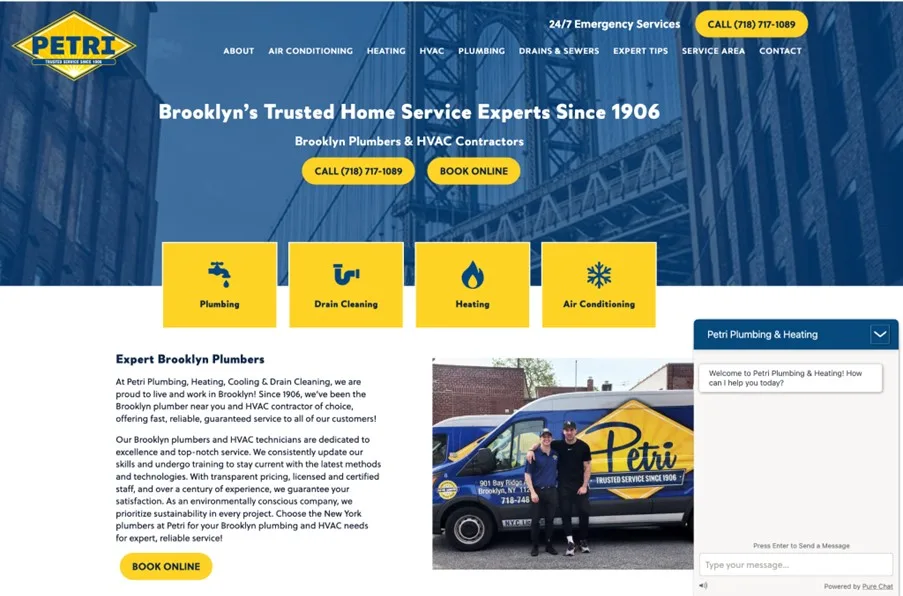
Even if you’re not reading very closely, the homepage makes it clear where the business is located. From the background photo featuring the Brooklyn Bridge to the inclusion of “Brooklyn” in the first three headlines and subheads on the page, the homepage is highlighting the location repeatedly.
2. Education homepage with a strong value proposition
Conventional marketing wisdom says that visitors spend 50-60 seconds on a webpage. That means you’ve got less than a minute to make it clear to visitors what you do and why you do it. Sharing your value proposition right at the top of your homepage ensures you get your mission across right away.
This local tutoring business keeps it simple: “SAT & ACT Prep That Gets Results. Better Tutors Mean Better Scores.” Visitors know instantly what the business does (college test prep) and why it matters (kids perform better on tests).
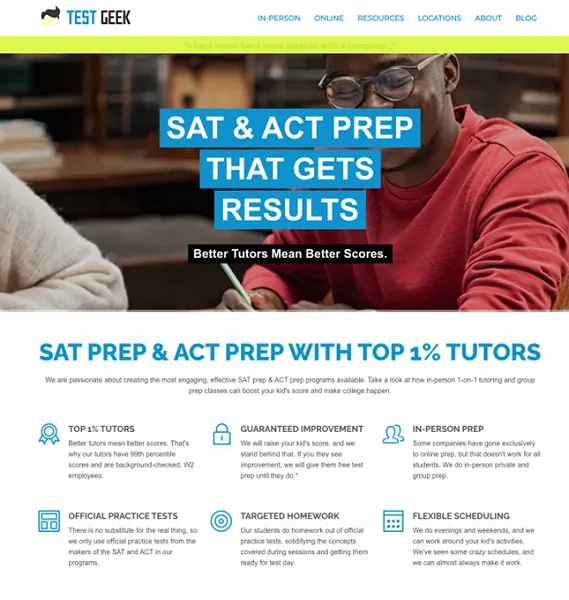
That compelling headline leads into additional benefits-focused copy. It highlights the quality of the company’s offering by talking about their top-notch tutors and their use of official test prep materials.
If you’re a parent evaluating options for your high schooler, this homepage would immediately draw you in and address a number of your potential questions or objections right away.
⚡ Ready to put this into practice? Download our free guide on how to create a unique value proposition from the ground up!
3. Dental homepage with a services list
Nearly half of all US adults feel anxiety before visiting the doctor. If you work in the healthcare space, it’s vital that your homepage immediately feels welcoming and puts prospective patients at ease.
That’s exactly what this Portland-based dental office does. The headshots of the smiling dentists portray them as kind practitioners, with great teeth, to boot!
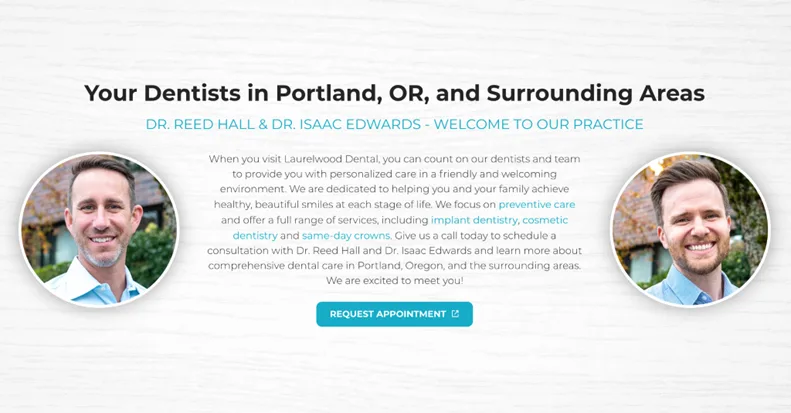
After putting readers at ease, the copy goes on to list the range of services available at the office, and includes links out to service pages for each one. The welcome letter wraps up with a simple CTA: “Request Appointment.”
4. Auto homepage complete with clear CTAs
A CTA invites a website visitor to take the next step with your business. On website subpages, determining the correct CTA is often straightforward. A retail product page will likely contain a “Buy Now” CTA button, while a contact page for a restaurant will invite users to make a reservation.
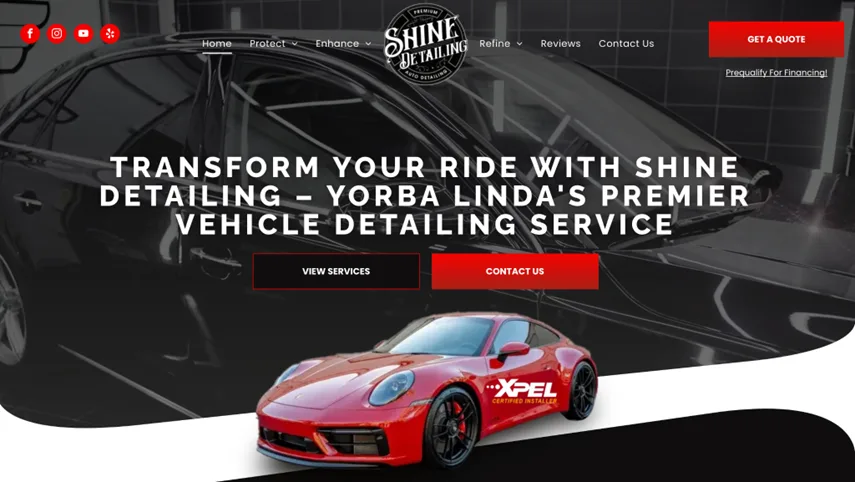
On your homepage, you’re serving a wider audience. Some visitors will be existing customers looking to re-engage with your business. Others will be first-time readers who need to know more before they’re ready to buy.
This car detailing business includes three separate CTA buttons designed to appeal to audiences at different stages of the customer journey:
- The “View Services” button is great for new visitors who simply want to learn more about their options.
- The “Contact Us” button is a fit for those who may be in the consideration phase and need to ask a few questions before they’re ready to buy.
- The “Get a Quote” button is for more serious leads. They’ve seen something they like, and they just need pricing information before they make a decision.
5. Finance homepage using personalized social proofs
Much of the real estate on your homepage is dedicated to talking about your business, sharing your value proposition, and details like your services or product benefits.
But to really make a strong first impression on visitors, it helps to add some social proof, too. Whether in the form of customer testimonials, reviews, or case studies, social proof is where you allow others to speak about positive interactions with your business.
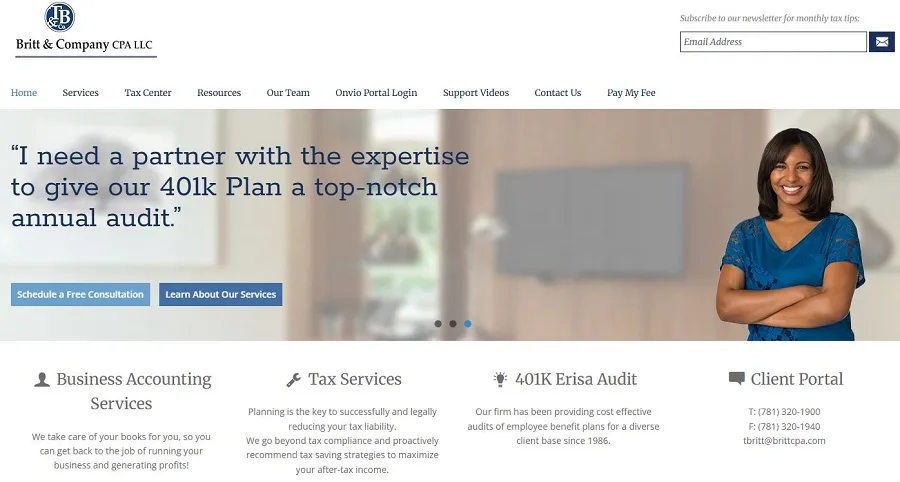
Any kind of social proof can be a powerful marketing tactic—72% of people say positive reviews make them trust a local brand more—but this CPA business takes things to the next level.
The CPA firm serves several different audiences, including individuals and business owners. The homepage has a carousel that includes quotes and photos from real customers that represent different buyer personas. No matter who’s visiting this homepage, they’ll find social proof that resonates with them.
6. Travel and tourism homepage that tells a story through imagery
For businesses in the travel and entertainment space, sometimes a picture is worth more than a thousand words. This industry is all about creating an experience for customers, and imagery can convey that in a way words can’t.
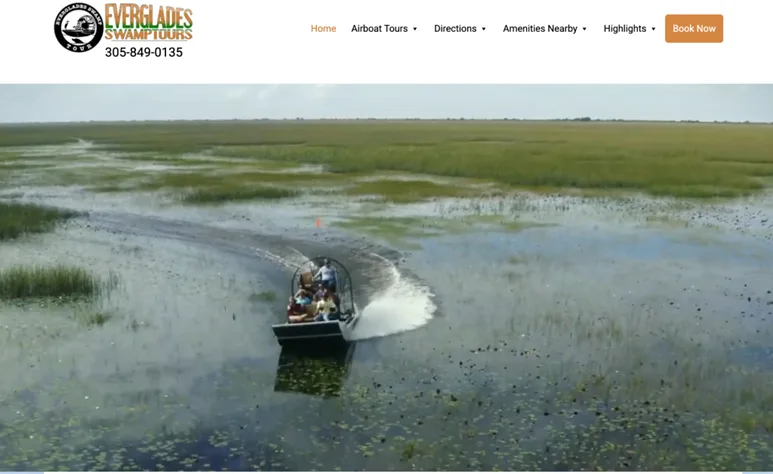
This homepage for an Everglades boat tour lets drone footage from the swamp do the talking. The video takes up nearly all the space above the fold, and it shows an airboat sweeping through the reedy waters of the Everglades.
Watching the video, you can practically feel the wind in your hair and the vibrations from the giant fan. Once visitors have seen what the experience is like firsthand, they’re invited to “Book Now” with the bright orange CTA button in the upper corner.
7. Local retail homepage encouraging in-store visits
When you’re running a local retail store, it’s essential that cutomers know when and where to find you.
This local bookstore cuts right to the chase: Its hours and location are front and center on the homepage, along with an invitation to “Come visit us.”
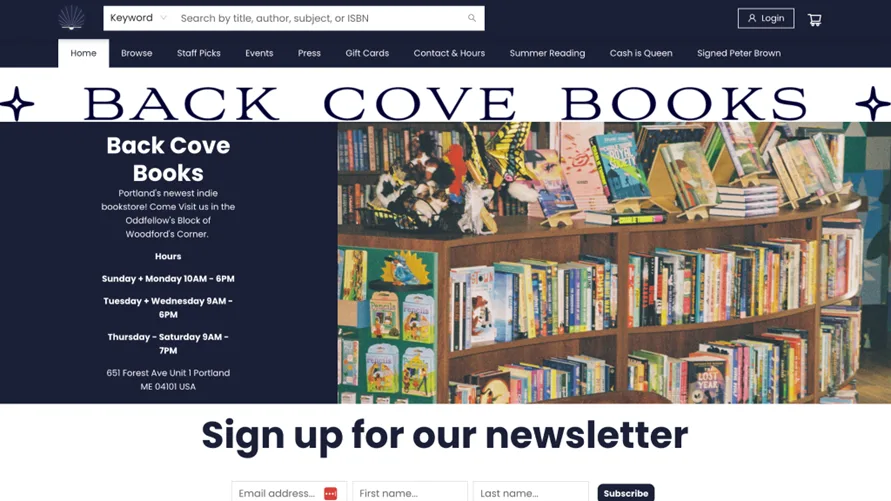
In addition to its full address, which is helpful for local SEO and consumers who’ll want to plug it into their GPS, the bookstore includes a general description of its location in relation to other town landmarks, making it easier for people on foot to locate the store.
8. Legal homepage with easy-to-use navigation
Your navigation bar is technically not part of your homepage—it’s a universal element across your site. But your homepage is the first place many visitors will encounter your navigation bar, so you want it to contain relevant subpages that invite visitors to dig deeper into your site.
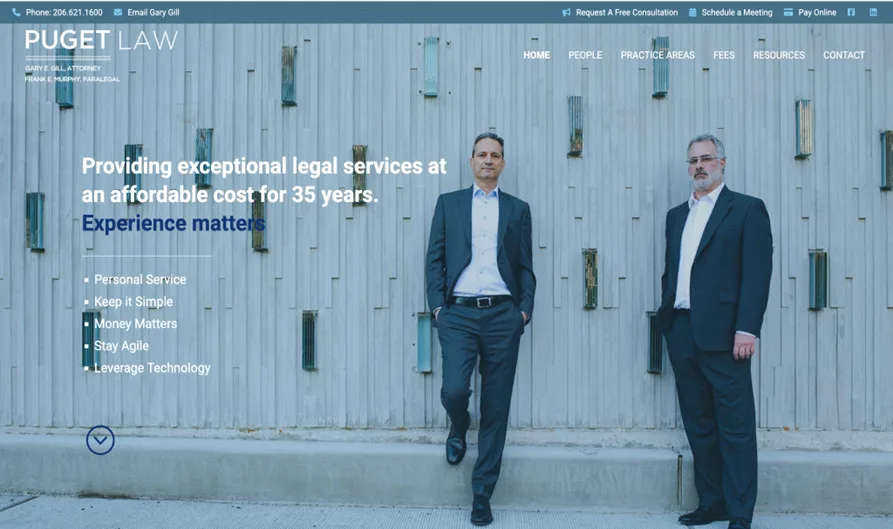
This law firm does a great job of designing its navigation bar to tie into the value proposition on its homepage. “Providing excellent legal service at an affordable cost for 35 years,” highlights the firm’s people and values.
If that value proposition resonates with a visitor, the next two questions they’ll likely have are: Who are these attorneys, and what do their services actually cost?
The navigation bar makes it easy for visitors to get answers to those questions, inviting them to visit a page for “People” and another for “Fees.”
9. Interactive personal services homepage
Many businesses serve more than one audience. The smart ones make it easy for those distinct personas to select their own path on their website.
This local florist has two offerings for two separate audiences. One is its floral design studio, a service that creates arrangements for weddings and events. The other is its flower shop, which sells products like houseplants and ceramic pots.

Instead of mingling the messaging for these two very different offerings, the homepage keeps it simple: It allows visitors to pick their own journey. Each side of the homepage has a CTA button that directs visitors to the landing page for either the studio or the shop.
10. Conversion-friendly healthcare homepage
A well-designed homepage can do more than one thing for visitors. It doesn’t just introduce your value proposition or list off services—it can tell an entire story that removes any potential objections and invites prospects to take the next step with your brand.
This homepage for an urgent care provider shows how copy can address the things that stand in the way of a prospect’s decision.
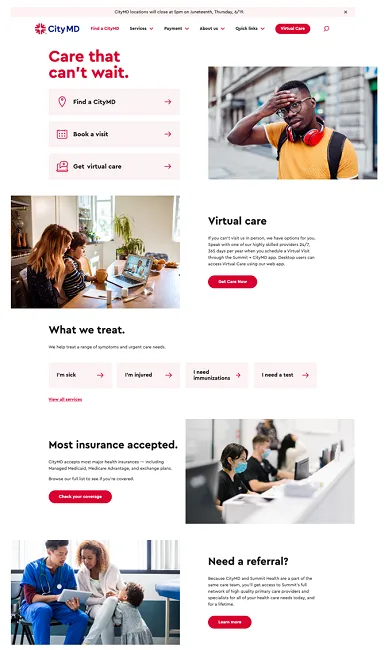
Think about the last time you were looking for a doctor. What are the hurdles that might prevent you from booking an appointment?
- Are they accessible (nearby or available for virtual appointments)?
- Can they address your medical issue?
- Do they take your insurance?
- Can you visit them without a referral?
If a doctor’s office can answer “yes” to all these questions, you just might make an appointment!
This business understands that these are the common questions that stand in prospective patients’ way, and so they have answers for each on their homepage.
💡 Turn your homepage into a lead-generating powerhouse using our free guide to fast and easy ways to get free leads (plus examples you can copy)!
Building a website homepage that works for you
Now that you understand the elements that make a homepage great, you can go out and create the best homepage for your website.
By creating a page with the images and copy that speak to your target audience and clearly communicate what you do, you have the chance to stand out in your local market and attract new and existing clients alike (and while you’re at it, create an about us page that solidifies your brand).
Remember to incorporate the following as you create your best homepage:
- Local SEO tactics to attract a relevant audience
- A well-designed navigation bar
- A clear value proposition, which states what you do and why you do it
- Copy that shares what you do (e.g., a high-level list of products/services)
- Social proof (e.g., testimonials, reviews, case studies)
- Relevant images or video
- Your business contact information
- A clear call to action (CTA)







